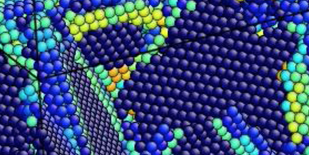Although they may seem benign, hydrogen (H) and helium (He) can both cause severe embrittlement in structural materials. H embrittlement is especially problematic in acidic environments, such as those encountered in deep oil wells, while He embrittlement may occur in nuclear reactors. By controlling how H and He atoms diffuse, cluster, and interact with crystal defects, we are designing new embrittlement-resistant materials for energy applications.

A. Kashinath, A. Misra, and M. J. Demkowicz, “Stable Storage of Helium in Nanoscale Platelets at Semicoherent Interfaces,” Physical Review Letters 110, 086101 (2013) http://prl.aps.org/abstract/PRL/v110/i8/e086101
A. Kashinath, P. Wang, J. Majewski, J. K. Baldwin, Y. Q. Wang, and M. J. Demkowicz, “Detection of helium bubble formation at fcc-bcc interfaces using neutron reflectometry,”” Journal of Applied Physics 114, 043505 (2013) http://link.aip.org/link/doi/10.1063/1.4813780
M.J. Demkowicz, A. Misra, A. Caro, “The role of interface structure in controlling high helium concentrations,” Current Opinion in Solid State and Materials Science 16, 101 (2012) http://dx.doi.org/10.1016/j.cossms.2011.10.003
M. Seita, J. P. Hanson, S. Gradecak, and M. J. Demkowicz, “The dual role of coherent twin boundaries in hydrogen embrittlement,” Nature Communications 6, 6164 (2015)
V. Yuryev and M. J. Demkowicz, “Computational design of solid-state interfaces using O-lattice theory: An application to mitigating helium-induced damage,” Applied Physics Letters 105, 221601 (2014).